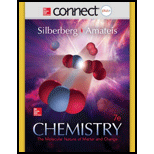
Concept explainers
(a)
Interpretation:
The mass percentage of
Concept introduction:
Mass percent is employed to determine the concentration of one compound in a mixture of the compound. The formula to calculate mass percent is as follows:
(a)
Answer to Problem 4.137P
The mass percentage of
Explanation of Solution
Consider the mass of
The formula to calculate the volume of the alloy is as follows:
Consider
The formula to calculate the volume of
Consider
The formula to calculate the volume of
Consider
The formula to calculate
Substitute
The expression to calculate the mass percent of
Substitute
The mass percentage of
(b)
Interpretation:
The mass percentage of
Concept introduction:
Stoichiometry of a reaction is utilized to determine the amount of any species in the reaction by the relationship between the reactants and products.
Consider the general reaction,
One mole of
(b)
Answer to Problem 4.137P
The mass percentage of
Explanation of Solution
The reaction of
Consider the mass of
The formula to calculate moles of
Substitute
The formula to calculate moles of
Substitute
The formula to calculate
Substitute
Substitute
The mass percentage of
(c)
Interpretation:
The mass percentage of
Concept introduction:
Stoichiometry of a reaction is utilized to determine the amount of any species in the reaction by the relationship between the reactants and products.
Consider the general reaction,
One mole of
(c)
Answer to Problem 4.137P
The mass percentage of
Explanation of Solution
The reaction of
Consider the mass of
The formula to calculate the mass of
Substitute
The formula to calculate the mass of
Substitute
The formula to calculate
Substitute
Substitute
The mass percentage of
Want to see more full solutions like this?
Chapter 4 Solutions
Connect 2-Year Access Card for Chemistry: The Molecular Nature of Matter and Change
- : ☐ Х Draw an α amino acid with a hydroxyethyl (-CH2-CH2- OH) side chain. Draw the molecule as it would appear at physiological pH. Click and drag to start drawing a structure. 5 Parrow_forwardDraw the product of the reaction shown below. Ignore inorganic byproducts. cat. H2SO4 HNO3 (1 equiv) Drawing Qarrow_forwardProvide the correct systematic name for the compound shown here.arrow_forward
- Using the appropriate bond energies, calculate the heat of reaction AH for the following reaction: H-H + CI-CI 2 H-CI You can find a table of bond energies by using the Data button on the ALEKS toolbar. Round your answer to the nearest kJ/mol. Note: For clarity, all lone pairs have been omitted from the molecular structures. ☐ kJ mol ค 000 Ar Barrow_forwardPredict the hydrocarbon, of formula C6H10, needed to prepare the following geminal dibromide upon treatment with excess hydrobromic acid. Note: The shown product is the only regioisomer formed in this reaction. HBr H₂C. CH3arrow_forwarddraw the major product formed with the listed reagentsarrow_forward
- Propose Williamson ether syntheses for the following compoundsarrow_forwardIdentify all functional groupsarrow_forwardA mixture of CaCO3 and MgC2O4 of unknown mass was heated in a 0.5 L closed rigid vessel to 900 degrees C.at 400C the following reaction occurs:MgC2O4 -> MgO (s) + CO (g) + CO2 (g)At 700C a second reaction occurs: CaCO3 -> CaO (s) + CO2 (g)The solid mass in the vessel was measured to be 3.06 g at 400C and 2.03g at 900CQuestion: What is the partial pressure of CO in both temperatures? (400 and 900C), provide detailed explanation.arrow_forward
- For the following alkyne, complete the reaction sequentially (that is draw the intermediate that we can’t stop at) and then name (complete name) all 3 molecules.arrow_forwardGiven the reaction sequence below, answer the following. A. Provide the structure for A. B. Provide the structure for B (pay attention to stereochemistry). C. Provide the structure for C. D. What are the stereochemical designations for I and II (R/S)?arrow_forwardWhich of the following is the most stable carbon radical?arrow_forward
 ChemistryChemistryISBN:9781305957404Author:Steven S. Zumdahl, Susan A. Zumdahl, Donald J. DeCostePublisher:Cengage Learning
ChemistryChemistryISBN:9781305957404Author:Steven S. Zumdahl, Susan A. Zumdahl, Donald J. DeCostePublisher:Cengage Learning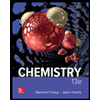 ChemistryChemistryISBN:9781259911156Author:Raymond Chang Dr., Jason Overby ProfessorPublisher:McGraw-Hill Education
ChemistryChemistryISBN:9781259911156Author:Raymond Chang Dr., Jason Overby ProfessorPublisher:McGraw-Hill Education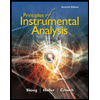 Principles of Instrumental AnalysisChemistryISBN:9781305577213Author:Douglas A. Skoog, F. James Holler, Stanley R. CrouchPublisher:Cengage Learning
Principles of Instrumental AnalysisChemistryISBN:9781305577213Author:Douglas A. Skoog, F. James Holler, Stanley R. CrouchPublisher:Cengage Learning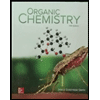 Organic ChemistryChemistryISBN:9780078021558Author:Janice Gorzynski Smith Dr.Publisher:McGraw-Hill Education
Organic ChemistryChemistryISBN:9780078021558Author:Janice Gorzynski Smith Dr.Publisher:McGraw-Hill Education Chemistry: Principles and ReactionsChemistryISBN:9781305079373Author:William L. Masterton, Cecile N. HurleyPublisher:Cengage Learning
Chemistry: Principles and ReactionsChemistryISBN:9781305079373Author:William L. Masterton, Cecile N. HurleyPublisher:Cengage Learning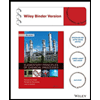 Elementary Principles of Chemical Processes, Bind...ChemistryISBN:9781118431221Author:Richard M. Felder, Ronald W. Rousseau, Lisa G. BullardPublisher:WILEY
Elementary Principles of Chemical Processes, Bind...ChemistryISBN:9781118431221Author:Richard M. Felder, Ronald W. Rousseau, Lisa G. BullardPublisher:WILEY





